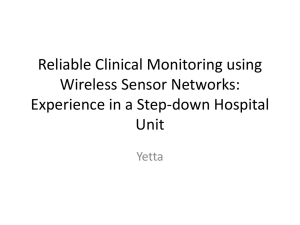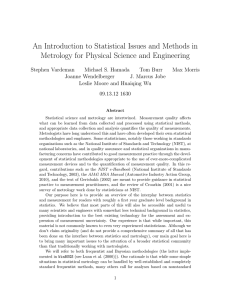File - IBT LUMHS
advertisement
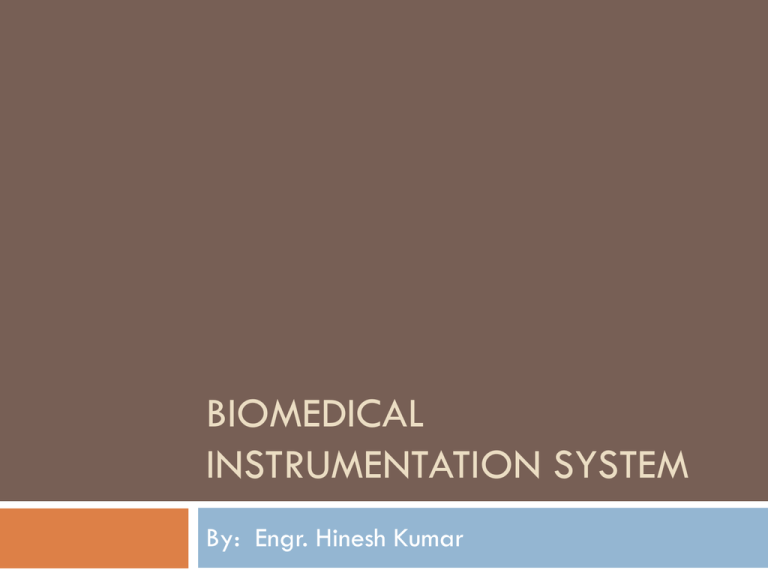
BIOMEDICAL INSTRUMENTATION SYSTEM By: Engr. Hinesh Kumar Outline Generalized Medical Instrumentation Systems Components of Medical Instrumentation Systems PC Based Medical Instruments Systems Operational Modes Medical Measurement Constraints Classifications of Biomedical Instruments Measurements Input Source Characteristics of Instrument Performance System Static & Dynamic Characteristics General Design Criteria & Process of Medical Instruments Commercial Medical Instrumentation Development Process Basic Instrumentation System Generalized Medical Instrumentation System * Elements and connections shown by dashed lines are optional for some applications. Generalized Medical Instrumentation System Components of Medical Instrumentation System Measurand Sensor / Transducer Signal Conditioning Output Display Auxiliary Components Measurand The physical quantity, property, or condition that the system measures is called measurand. The accessibility of the measurand is important because it may be: Internal (Blood Pressure) On the Body Surface (Electrocardiogram) Emanate from the body (Infrared Radiation) Derived from Tissue Sample (such as Blood or a Biopsy) Cont… Most medically important measurands can be grouped in the following groups: Biopotential, Pressure, Flow, Dimensions (Imaging), Displacement (Velocity, Acceleration, And Force), Impedance, Temperature, And Chemical Concentrations The measurand may be localized to a specific organ or anatomical structure. Sensor The transducer is defined as a device that converts one form of energy to another. A sensor converts a physical measurand to an electric output. The sensor should respond only to the form of energy present in the measurand, to the exclusion of all others. The sensor should non invasive and minimally invasive. Signal Conditioning Simple signal conditioners may only amplify and filter the signal or merely match the impedance of the sensor to the display. Often sensor outputs are converted to digital form and then processed by specialized digital circuits or a microcomputer. For example, signal filtering may reduce undesirable sensor signals. It may also average repetitive signals to reduce noise, or it may convert information from the time domain to the frequency domain. Output Display The results of the measurement process must be displayed in a form that the human operator can perceive. The best form for the display may be: Numerical Graphical, Discrete or Continuous, Permanent or Temporary Visual / Hearing Auxiliary Components A calibration signal with the properties of the measurand should be applied to the sensor input or as early in the signal-processing chain as possible. Many forms of control and feedback may be required to elicit the measurand, to adjust the sensor and signal conditioner, and to direct the flow of output for display, storage or transmission. The control and feedback may be automatic or manual. Cont… Data may be stored briefly to meet requirements of signal conditioning or to enable operator to examine the data that precede alarm conditions. Or data may be stored before signal conditioning, so that different processing schemes can be utilized. Conventional principles of communication can often be used to transmit data to remote displays at nurses’ stations, medical centers, or medical dataprocessing facilities. PC Based Medical Instruments Personal computer are popular in medical field and also software is largely commercially available and the users can purchase and use it. Computer are widely accepted in the medical field for data collection, manipulation, processing and a complete workstations for a variety of applications. A personal computer becomes a workstation with the simple installation of one or more “instrumentson-a-board” in its accessory slots. PC Based Medical Instruments Typical configuration of PC based Medical Instruments Cont… Fig illustrates the typical configuration of a PC based workstation. System is highly flexible and can accommodate a variety of inputs, which can be connected to PC for analysis, graphics and control. Basic elements in the system include sensors or transducers that convert physical phenomena into a measurable signal, a data acquisition system, an acquisition/analysis software package or programme and computing platform. The systems works totally under the control of software. Cont… PC medical instruments are gaining in popularity for several reasons including price, programmability and performance specifications. Software development, rather than hardware development, increasingly dominates new product design cycles. This includes operating systems, devices drivers, libraries, languages and debugging tools. Categories of Measurement There are three general categories of measurement 1. Direct Measurement 2. Indirect Measurement 3. Null Measurement Direct Measurement Direct measurement are made by holding the measurand up to some calibrated standard and comparing two. Example: Meter stick ruler used to cut a piece of coaxial cable to the correct length. You know that the cable must be cut to a length of 24 cm, so hold a meter stick (the standard or reference) up to the piece of the cable. Measuring cable with a meter stick Indirect Measurement Indirect measurement are made by measuring something other than the actual measurand. Indirect methods are often used when direct measurements are either difficult or dangerous. Example: on might measure the temperature of a point on the wall of a furnace that is melting metal. Measuring point on a furnace Indirect Measurement of blood pressure Null Measurement Null measurement are made by comparing a calibrated source to an unknown measurand and then adjusting either one or the other until difference between them is zero. Example: An electrical potentiometer is such an instrument; it is an adjustable calibrated source and a comparison meter (galvanometer). The reference voltage from the potentiometer is applied to one side of the zero center galvanometer, and the unknown is applied to the other side of galvanometer. The output of the potentiometer is adjusted until the meter reads zero difference. Example of Null Measurement Instruments Operational Modes Direct / Indirect Mode Sampling and Continuous Modes Generating and Modulating Modes Analog and Digital Modes Real time and Delayed Time Modes Direct / Indirect Modes Direct Mode Desired measurand can be interfaced directly to a sensor because the measurand is readily accessible If the sensor is invasive, direct contact with the measurand is possible but expensive, risky and least acceptable. Temperature Heartbeat Indirect Mode Desired measurand can not be interfaced directly and not accessible Morphology of internal organ: X-ray shadows Volume of blood pumped per minute by the heart: respiration and blood gas concentration Pulmonary volumes: variation in thoracic impedance plethysmography Sampling Mode and Continuous Mode Sampling Mode Sampling can change so slowly that they may be sampled infrequently. Body Temperature Ion Concentration Continuous Mode Frequent or constant monitoring of measurand Electrocardiogram Respiratory Gas Flow Generating and Modulating Modes Generating Mode Generating sensors produce their signal output from energy taken directly from the measurand. Also known as self-powered modes. Example: Photovoltaic cell is a generating sensor because it provides an output voltage related to its irradiation, without any additional external energy source. Modulating Mode Modulating sensors use the measurand to alter the flow of energy from an external source in a way that affects the output of the sensor. Example: Photoconductive cell is a modulating sensor; to measure its change in resistance with irradiation, we must apply external energy to the sensor. Analog and Digital Modes Analog Modes Analogue or Continuous signal is able to take any value within a dynamic range. Most currently available sensors operate in the analog mode. Digital Modes Digital or Discrete signal is able to take on only a finite number of values. The advantages of the digital mode of operation include greater accuracy, repeatability, reliability, and immunity to noise. Real Time and Delayed Time mode Real Time Mode Sensor acquire the signal in real-time mode The result are displayed immediately Delayed Time Mode Display results are delayed due to image processing such as averaging and transformations. General Constraint In Design of Medical Instrumentations Systems Medical equipment are primarily used for making measurements of physiological parameters of the human body and also in some cases as stimulus or some kind of energy is applied to the human body for diagnosis and treatment. Some of important factors, which determine the design of a medical measuring instrument, are: Measurement Range: Generally the ranges are quite low compared with non-medical parameters. Most signals are in microvolt range. Frequency Range: Most of the biomedical signals are in the audio frequency range or below and many signal contain dc and very low frequency components Cont…. The signal to be measured imposes constraints on how it should be acquired and processed. Many measurand in living systems are inaccessible. Placement of sensor(s) in/on the body plays a key role in medical instrumentation design. Magnitude and frequency range of medical measurand are very low. Interference and cross-talk artifacts. Proper sensor interface with measurand cannot be obtained. Medical variables are seldom deterministic (varying with time). Cont…. Many medical measurements vary widely among normal patients, even when conditions are similar. Safety of patient and medical personnel also must be considered. Safe levels of stimulation or applied energy are difficult to establish, External energy must be minimized to avoid any damage. Equipment must be reliable, easy to operate, and durable. Government regulations. Common Medical Measurands Classifications Of Medical Instruments Medical Instruments can be classified in the four categories 1. Quantity that Sensed 2. Principle of Transduction 3. Organ System 4. Clinical Medicine Specialties Classifications 1. Quantity That Sensed Advantage of this classifications is that it makes different methods for measuring any quantity easy to compare. Pressure Flow Temperature 2. Principle of Transduction Resistive Inductive Capacitive Ultrasonic (Sound waves) Electrochemical (pH probe, Hydrogen Sensor) Cont… 3. Organ System Isolates all important measurements for specialists who need to know only about a specific area Cardiovascular Systems Pulmonary System Nervous System Endocrine System Cont…. 4. Clinical Medicine Specialties This approach is valuable for medical personnel who are interested in specialized instruments. Pediatrics Obstetrics Cardiology Radiology. Measurement Input Sources 1. 2. Desired Inputs: Measurands that the instrument is designed to isolate. Interfering Inputs: Quantities that accidentally affect the instrument as a consequence of the principles used to acquire and process the desired inputs. 3. Modifying Inputs: Quantities that cause a change in the input –output relations of the instrument. Example: ECG Signal Measurement Desired Input: ECG voltage (Vecg) 1. Interfering Input: 60/50 Hz noise voltage, displacement currents 2. Modifying Input: – orientation of the patient cables when the plane of the cable is perpendicular to the magnetic field the magnetic interference is maximal 3. Figure: Simplified electrocardiographic recording system Two possible interfering inputs are stray magnetic fields and capacitive coupled noise. Orientation of patient cables and changes in electrode–skin impedance are two possible modifying inputs. Z1 and Z2 represent the electrode–skin interface impedances.
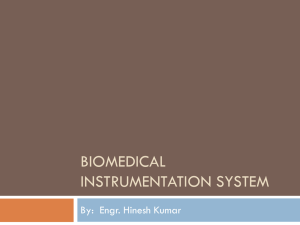
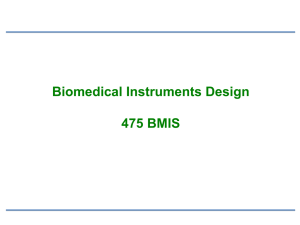
![Transducers_1[1]](http://s2.studylib.net/store/data/005329047_1-b90da3eabfa98717d13e735055577e1f-300x300.png)






